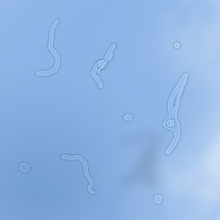Floater
Floaters or eye floaters are small dots in the field of vision of a person. They are transparent and between the eye's vitreous humour or between the vitreous and retina. Their medical name is muscae volitantes (Latin for 'flying flies'), or mouches volantes (French for 'flying flies').[1] All people will get them over time,[2] but not all will notice them. Nearsighted people can notice them earlier.[3] It might be possible to get these by debris falling into the eye. They are common in most people. They would constantly be seen by looking at the sky or a source of a light. They are not to be confused with Afterimages or Blue field entopic phenomenon.

They can appear in various different shapes, such as strands, dots, rods, and cobwebs. Additionally, there is a ring shaped floaters named the Weiss Ring,[4] they are sometimes seen if the vitreous releases from the back of the eye.
How they are formed
changeThe vitreous, a jelly-like material inside the eyeball, becomes more liquid.[5] This happens when people age.[5] But young people can also get them.[3] When this happens, small collagen fibers and vitreous form to clumps.[5] These clumps throw shadows onto the retina.[5] These shadows are floaters.[5]
Treatment
changeVitrectomy and laser vitreolysis are possible treatment options for the removal of floaters.
References
change- ↑ Adult Eye Health: Mayo Clinic Radio (5 minutes in to 8 minute talk)
- ↑ "Eye Floaters–How do we get them? | CooperVision". coopervision.com. Retrieved 2020-07-25.
- ↑ 3.0 3.1 "Was sind eigentlich ... Mouches volantes". DAZ.online. 2009-01-15. Retrieved 2020-10-24.
- ↑ "What are Weiss rings and blepharitis?".
- ↑ 5.0 5.1 5.2 5.3 5.4 "Eye floaters". Mayo Clinic. Retrieved 2020-07-25.